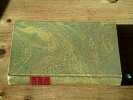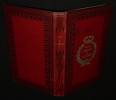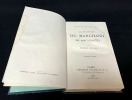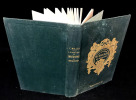3794 books for « muller f »Edit
-
Type
Autograph (1)
Book (3771)
Disk (1)
Drawings (2)
Engraving (2)
Magazine (7)
Music sheets (10)
-
Latest
Last 3 days (3)
Last month (202)
Last week (3)
-
Language
English (7)
French (3769)
German (7)
Greek (1)
Russian (10)
-
Century
16th (7)
17th (2)
18th (39)
19th (331)
20th (1461)
21st (297)
-
Countries
Belgium (268)
Canada (8)
China (1)
Denmark (121)
France (2657)
Germany (1)
Greece (5)
Italy (9)
Netherlands (35)
Switzerland (674)
United Kingdom (6)
United States of America (9)
-
Syndicate
ALAC (8)
CLAM (5)
CLAQ (2)
CNE (2)
ILAB (1751)
NVVA (224)
SLACES (224)
SLAM (1301)
SNCAO (5)
Topics
- Adam (9)
- Alps (17)
- Alsace (126)
- Ampelography - wines (20)
- Animals (11)
- Aquitaine (10)
- Archaeology (73)
- Architecture (41)
- Belgium (12)
- Bible (9)
- Bibliography (9)
- Biography (39)
- Birds (10)
- Botany (24)
- Brittany (12)
- Children’s books (60)
- Christianity (18)
- Cooking (22)
- Dauphiné (26)
- Dedication (13)
- Detective novels (12)
- Dictionaries (11)
- Drawings (16)
- Early printed books (16)
- Economics (30)
- Education (21)
- Education - morals (13)
- Egypt (14)
- Engravings (9)
- Entomology (13)
- Ethic (11)
- Europe (10)
- Fashion (10)
- Fine arts (37)
- First edition (30)
- Fishing (12)
- Florence (22)
- Forez (9)
- Geography (37)
- Germanic languages (170)
- Germany (41)
- Greece (13)
- Greek (16)
- Helvética (186)
- History (216)
- Ile de france (10)
- Illustrated books (9)
- India (9)
- Industrial arts & crafts - fine arts (19)
- La tour du pin (9)
- Latin (12)
- Law (30)
- Linguistics (21)
- Literature (280)
- Magazine (26)
- Medicine (62)
- Military arts (32)
- Muller charles (41)
- Muller eugène (74)
- Müller herta (12)
- Muller jean (30)
- Muller joseph-emile (27)
- Muller martine marie (22)
- Muller rené (19)
- Music (11)
- Navy (14)
- Newspapers press (32)
- Painters (21)
- Painting (17)
- Palaeontology (9)
- Philology (12)
- Philosophy (67)
- Photography (22)
- Poetry (11)
- Policy (19)
- Printing (9)
- Psychiatry neurology (16)
- Psychology (37)
- Reboux paul (24)
- Regionalism (25)
- Religions (54)
- Review (18)
- Reviews (27)
- Scandinavian literature (10)
- Sciences (32)
- Scores (32)
- Shapes & colours (9)
- Songs (12)
- Sports (10)
- Switzerland (187)
- Theatre (17)
- Theology (35)
- Travel (24)
- Various (27)
- Viticulture (16)
- War (38)
- Wine (25)
- Youth (28)
- Zoology (12)
- Zurich (17)
Hippolyte Muller (1865-1933)
Imprimerie du Comtat 1938 14 pages in8. 1938. Broché. 14 pages. Avec un bois original de Jean Muller. Poids : 80 gr
Bon Etat Couverture frottée au dos sinon bon état
La peinture moderne
Hazan Fernand Broché 1986 In-8 (16 x 18 cm.), broché, couverture illustrée, 141 pages, planches couleurs ; plats légèrement défraîchis, bon état. Livraison a domicile (La Poste) ou en Mondial Relay sur simple demande.
Leos Janacek
Editions d'Aujourd'hui Les Introuvables Dos carré collé 1975 In-8 (14,8 x 20,5 cm), dos carré collé, 94 pages + illustrations in fine ; mors légèrement fendus aux coiffes, pliure au dos, assez bon état général. Livraison a domicile (La Poste) ou en Mondial Relay sur simple demande.
Elisasz
NEL-Verlag Dos carré collé 1998 In-12 (11,6 x 18,1 cm), dos carré collé, 245 pages, envoi de l'auteur ; petite trace au premier plat, par ailleurs très bon état général. Livraison a domicile (La Poste) ou en Mondial Relay sur simple demande.
Religions et territoires
L'Harmattan Géographie sociale Dos carré collé 1999 In-8 (15,7 x 24 cm), dos carré collé, 291 pages ; très bon état. Livraison a domicile (La Poste) ou en Mondial Relay sur simple demande.
"L'Association ""E 525"" vous présente... la 2D2 5525"
Association E 525 Plaquette 1991 In-8 (15 x 21 cm), plaquette agrafée, 15 pages, figures en noir ; très bon état. Livraison a domicile (La Poste) ou en Mondial Relay sur simple demande.
Récits enfantins
Jung-Treuttel Relié In-8 (16 x 23,7 cm), reliure demi-chagrin, dos à 5 nerfs orné de fleurs dorées, tranches dorées, sans date, 153 pages, gravures en noir hors texte dont un frontispice ; quelques épidermures sur le cuir, coins frottés, page de frontispice déréglée, par ailleurs bon état. Livraison a domicile (La Poste) ou en Mondial Relay sur simple demande.
Petits ours dans la forêt
Hachette Album cartonné 1962 In-4 (20,7 x 24,5 cm), album cartonné, non paginé, photographies en couleurs ; mors inférieur fendu sur 6 cm au centre, quelques marques d'usage au premier plat, état moyen. Livraison a domicile (La Poste) ou en Mondial Relay sur simple demande.
L'héritage, Quelle défense pour quel socialisme?
Combat non-violent Agrafé 1977 In-8 (13 x 21 cm.), agrafé, couverture illustrée, 57 pages ; plats un peu défraichis, dos et coiffes frottés, coins pliés, par ailleurs assez bon état. Livraison a domicile (La Poste) ou en Mondial Relay sur simple demande.
Signification de la non-violence, Combat non-violent n°43-44
Combat non-violent Agrafé 1974 In-8 (15,5 x 24 cm.), agrafé, couverture illustrée, 39 pages, périodique d'information sur l'Action Non-Violente en France et dans le monde, illustrations noir et blanc in-texte ; plats défraîchis, dos et coiffes légèrement frottés, nombreux soulignages au crayon bleu dans le texte, par ailleurs assez bon état. Livraison a domicile (La Poste) ou en Mondial Relay sur simple demande.
La bombe en question, Combat non-violent n°35-36-37
Combat non-violent Agrafé 1973 In-8 (15,5 x 24 cm.), agrafé, couverture illustrée, 52 pages, périodique d'information sur l'Action Non-Violente en France et dans le monde, illustrations noir et blanc in-texte ; plats défraîchis, dos et coiffes frottés, par ailleurs assez bon état. Livraison a domicile (La Poste) ou en Mondial Relay sur simple demande.
Le livre du plein air
Librairie Haar & Steinert, Holger Tillge éditeur Broché 1914 In-8 (14x21.5 cm), broché, 1er plat illustré, 196 pages, traduit du danois par Fr. Leray et E. Philipot, avec 37 illustrations (dont frontispice), 2e édition ; une fissure au dos, petits manques aux coiffes, menues déchirures en bordures, une déchirure (manque papier) sur le 1er plat, annotations à l'intérieur, état correct. Livraison a domicile (La Poste) ou en Mondial Relay sur simple demande.
Le livre du plein air
Librairie Haar & Steinert, Holger Tillge éditeur Relié 1909 In-8 (13.5x21 cm), reliure, titre et auteur dorés sur le 1er plat et au dos, couverture conservée, 196 pages, traduit du danois par Fr. Leray et E. Philipot, avec 37 illustrations (dont frontispice) ; très bon état. Livraison a domicile (La Poste) ou en Mondial Relay sur simple demande.
Dermatologie des petits animaux
Vigot Frères Cartonné avec jaquette 1969 In-8, (26x18.5 cm), cartonné sous jaquette illustrée, 552 pages, illustrations en couleurs et en noir et blanc, index, glossaire, appendices ; petites usures sur les bords de la jaquette, bon état général. Livraison a domicile (La Poste) ou en Mondial Relay sur simple demande.
Nizelle
Hennuyer Relié In-8, (18x11.5 cm), relié, demi-chagrin, plats de percaline, armoiries du Collège Rollin sur le 1er plat, 394 pages, sans date, illustrations en noir et blanc de Tofani, 2e édition ; rousseurs dans le texte, plats frottés, cuir légèrement usé, état correct. Livraison a domicile (La Poste) ou en Mondial Relay sur simple demande.
La Pêche et la conserve du thon dans la Bretagne de l'Atlantique
Paris, J. B. Baillière et fils Broché 1937 In-8 (16 x 24,8 cm), broché, 111 pages ; mors supérieur déchiré, quatrième plat manquant, par ailleurs corps d'ouvrage bien conservé, en l'état. Livraison a domicile (La Poste) ou en Mondial Relay sur simple demande.
A la manière de
Bernard Grasset 1910 331 pages in-12. 1910. Reliure à la bradel avec pièce de titre au dos Plats de la couverture conservés. 331 pages. Deuxième série - Et première série réunies en une édition complète
Bon état malgré une illustration sur le 1er plat conservé
La Révolution de 1848 en Alsace
Librairie Fischbacher, Imprimerie veuve Bader et Cie Relié 1912 In-8 (14,3 x 20,2 cm), reliure demi-toile, dos lisse, pièce de titre, 247 pages ; rousseurs au dos, coupes frottées, papier bruni, par ailleurs assez bon état général. Livraison a domicile (La Poste) ou en Mondial Relay sur simple demande.
Les origines de Grenoble
Grenoble Editions B. Arthaud 1930 39 pages in-8. 1930. broché. 39 pages. In-8 broché avec couverture illustrée (251x165 mm) 39 pages. Sa formation depuis l'époque gauloise jusqu'au VIIe siècle d'après les documents extraits de son sous-sol. Avec 12 figures en noir hors-texte. Couverture en bon état général brunie avec quelques taches au 1er plat. Intérieur propre. Poids : 180 gr
Un Siècle De Peinture Moderne
Paris Editeur Fernand Hazan 1972 192 pages in-4. 1972. cartonné. 192 pages. In-4 (316x250 mm) 192 pages. Cartonnage éditeur sous jaquette illustrée. Nombreuses illustrations en couleurs. A noter deux coupures à la jaquette dont une à un angle sinon bon état. Poids : 1490 gr
Ronde annuelle des marteaux-piqueurs ou La mutation d'un paysage
L'Ecole des Loisirs 1974 In-4 carré. 1974. En feuilles sous pochette illustrée. Complet des 7 planches dépliantes
Etat correct. Des frottements aux coins de la pochette sinon bon état
La jeunesse des hommes célèbres
J. Hetzel et Cie 328 pages in-8. Sans date. Percaline décorée au dos Toutes tranches dorées. 328 pages. Avec des gravures en noir et dessins par Emile Bayard
Très bon état général
Jeanne de Montfort : Leçons d'histoire et de morale
Megard et Cie Relié 1878 "In-8 (13,8 x 21,9 cm), cartonnage, dos lisse, ""Ecole communale de Clichy"" et lauriers dorés au premier plat, tranches dorées, 237 pages ; quelques traces sur les plats, rousseurs et traces à l'intérieur, assez bon état général. Livraison a domicile (La Poste) ou en Mondial Relay sur simple demande."
La boutique du marchand de nouveautés
Hachette et Cie Relié 1878 In-8 (11.5 x 18.5 cm),relié pleine percaline verte, dos lisse avec titre et auteur dorés, dorures au 1er plat, 241 pages, 3ème édition ; coiffes et coins frottés, quelques marques d'usage aux plats, petites mouillures sur le bord latéral en début d'ouvrage, par ailleurs intérieur plutôt bien conservé, assez bon état. Livraison a domicile (La Poste) ou en Mondial Relay sur simple demande.
Der Strassburger Blumenofen
Baumann & Cie, Banquiers Plaquette 1988 In-8 (14,7 x 21 cm), plaquette dos agrafé, 47 pages, iconographie en noir et en couleurs, texte en allemand ; très bon état général par ailleurs. Livraison a domicile (La Poste) ou en Mondial Relay sur simple demande.
 Write to the booksellers
Write to the booksellers


















